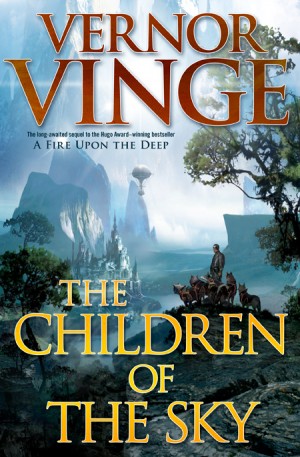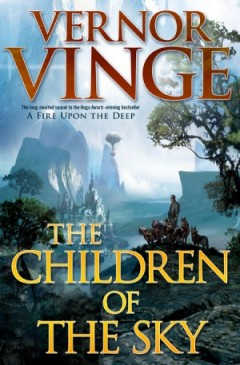
The Children of the Sky is the long-anticipated sequel to the Vernor Vinge’s Hugo Award–winning A Fire Upon The Deep. It is set in his Zones of Thought universe, which imagines a galaxy divided into regions that support different levels of technology and intelligence, from the easy FTL travel and posthuman Powers of the Transcend to the appropriately named Unthinking Depths at the galactic core.
The first time I read this book, I didn’t like it. I, like many others, was expecting a fast-paced adventure spanning the galaxy, such as A Fire Upon The Deep. Instead, the setting is limited to Tine’s World. I was looking for a satisfying resolution to the menace of the approaching Blight fleet, but the ahuman superintelligence stays comfortably in the background. I almost didn’t give it a second chance, but I did, and I appreciated it more the second time through. Once I got past the fact that this book was not what I was expecting, I enjoyed it, although it isn’t on the same level as A Fire Upon The Deep or A Deepness In The Sky.
The story starts 10 years after the ending of the previous book. Ravna Bergsndot leads the awakened Children, refugees from the Blight’s destruction of their home and stranded on Tine’s World. They are attempting to build a technological civilization capable of repelling the Blight with the help of the Out of Band II, the partially-functional starship that originally carried Ravna and the frozen Children to Tine’s World, and the Tines, a fascinating alien species made up of packs of 4 to 8 wolf-like creatures that act as a single individual.
Ravna and the Children have the support of Woodcarver, the ruler of an emerging empire. However, many of the Children are suspicious of Ravna’s interpretation of the Blight and the destruction of their home world, and in the far-off Tropics, a pack named Tycoon is starting an industrial revolution, assisted by Vendacious, Woodcarver’s traitorous spymaster.
One of my biggest problems with the book is the pacing; there are long stretches in which nothing much happens to move the plot along. The political intrique that is the main focus of the first half of the book is predictable and not particularly interesting, and the second half is mostly an excuse to explore Tine’s World.
Also, despite being the main threat at the end of A Fire Upon The Deep, the Blight is mostly ignored. The few scenes that do involve the Blight are confusing and badly integrated into the plot. Few of the questions posed by the previous book are answered, and the confrontation with the Blight will have to wait for a third book (for which plenty of room is left).
Another weakness is characterization. Surprisingly, I found most of the Tinish characters more realistic and sympathetic than any of the human ones (Vendacious, who appears to be evil for the sake of being evil, being the main exception). Ravna’s actions and motivations, in particular, sometimes just don’t make sense, and none of the humans are compelling enough to really care about.

On a positive note, Vinge’s world-building is, as always, fantastic. The Choir, a hive mind in the tropics of Tine’s World, only hinted at in A Fire Upon The Deep, is brought to the forefront and turns out to be much more than the mindless rabble that it appears to be. Tycoon’s interaction with the Choir is especially interesting; the description of a Choir-run factory is one of the high points of the book. Tinish psychology and society is further explored, including “broodkenning,” the art of blending members with different strengths into a coherent pack.
There is also exploration of the relationship between humans and their computers and other machines. The Children grew up on a world where their every need was taken care of by technology, and they find themselves thrust on a primitive planet where the skills they were learning are worthless and little details like weather can be fatal.
The occasional libertarian insights also spruce things up: human society in the Beyond is based on free trade and consensus, and Ravna and the Children bring some of that viewpoint to Tine’s World.
Overall, Children in the Sky doesn’t live up to the expectations set by A Fire Upon The Deep and A Deepness In The Sky, but is still readable and enjoyable, for the universe Vinge creates if nothing else. If you are a true fan of Vernor Vinge (like me), or can put up with the negatives for the world-building gems, give it a read. Otherwise, just wait for the next book.
















Comments on this entry are closed.
Matthew Alexander February 10, 2012 @ 10:41 am | Link
I am disappointed to read so many negative and neutral reviews of Vinge’s latest. I was never as enthralled with the Tines as many were, but A Fire was a solid book, and Deepness was great. Let’s hope the next one, say in 2016, wraps the series up as it deserves (let’s not turn this into another Robert Jordan catastrophe! Four books seems like enough).
random mike February 10, 2012 @ 7:16 pm | Link
I agree with your 3/5 rating. Worth reading but much weaker than Fire & Deepness. I thought the biggest flaw was the humans’ unbelievably epic fail. Tycoon’s rocking an industrial revolution while the humans, with a computer full of data about the best way to advance technoloogy, just fight each other and get kidnapped and accomplish very little in 10 years.
See my review here:
http://mikesrandomreviews.wordpress.com/2011/10/23/a-fire-upon-the-deepness-in-the-children-of-the-sky/